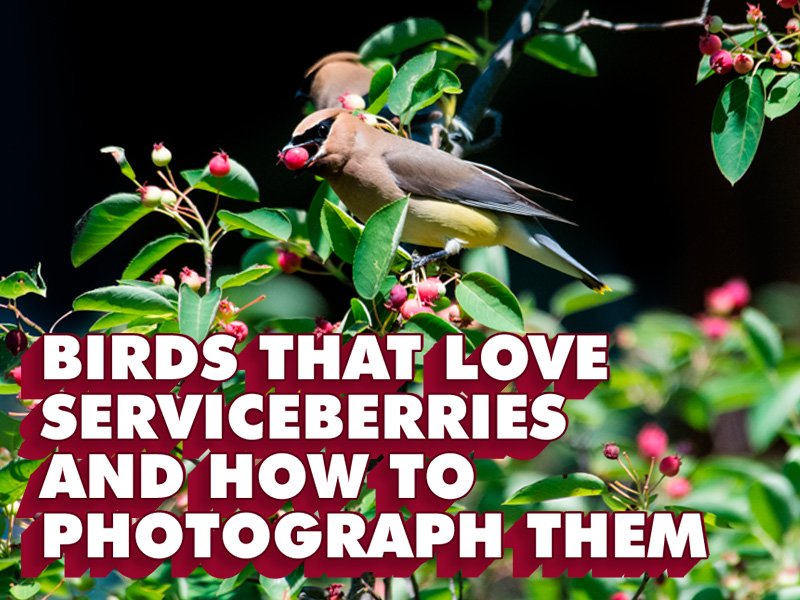Birds That Love Serviceberries and How To Photograph Them
Don Orkoskey | May 31, 2023

Learning about birds that love serviceberries and how to photograph them is a core memory when it comes to my bird photography journey. In this article I'm going to tell you about both serviceberries and the birds that love them as well as where to find them and how to photograph them.
Serviceberry Time
There is a reason they're also known as Juneberries, because June is Serviceberry time. Right now the trees and bushes are ripening and the birds are about to descend on them with reckless abandon.
What Are Serviceberries?
Serviceberries are a fruit in the rose family (so are apples before you begin to think that it's strange). In fact they taste a bit like tiny apples. They also go bad quickly and have a seed that takes up a lot of space in their tiny fruity body. Since they don't last long, much like mulberries, they are not widely available commercially.
What's In A Name?
Serviceberries are known as Saskatoons, Shadbush, Juneberries, and a bunch of other regional names. According to the University of Missouri they have over 35 common names throughout their native range. That probably has something to do with how widespread they are throughout most of continental North America.
Are They Edible?
You better believe that they're edible and they are incredibly tasty! Yes, as I already mentioned they do have a large seed for their small size. That being said, you can swallow the seed without problems. Just don't go too wild.
Like most fruit in the same family there are trace amounts of chemicals in the seeds that, if you ate more than you're likely capable of eating, could be harmful. Too, you can always just spit the seeds out.
If you are going to compete with the birds to eat them make sure you know that they're actually serviceberries that you're eating. There are a few trees that produce similar berries. In other words, don't eat them if you're not sure of what they are.
Where To Find Serviceberries
You can find serviceberries easily if you know what to look for. They've been planted as ornamental trees and bushes for decades, as they can take both forms.
If you're searching for serviceberries in the wild here is how to find them. First, these are small trees that can take on a shrub-shape. They don't often get taller than about 20' (6m). They prefer wet, boggy, swampy areas.
Serviceberries are really widespread. However, the easiest place to find them in not in the swamp but in a local park. Here in Pittsburgh where I live there are a lot of them planted around the Frick Environmental Center in Frick Park. They're planted there specifically for the birds so please don't eat them (at least don't eat more than a couple).
Check with your local park's department or other local groups that deal with tree planting. Another resource local to me is a group called Tree Pittsburgh.
Tree Pittsburgh is dedicated to advocating for and growing the urban forest around Pittsburgh. Additionally, they know the local trees. If you're trying to find serviceberries in your area then look for similar resources.
Birds That Love Serviceberries
There are a ton of birds that love serviceberries. In fact, many birds which are otherwise skittish and don't like people, often ignore people when they're chowing down on serviceberries.
Here is an (incomplete) list of birds you'll find in the serviceberries.
Common birds who love serviceberries
Here are some common birds who love serviceberries. Or, at least, common to my area:
- American Robins
- Northern Cardinals
- Red-bellied Woodpeckers
- Gray Catbirds
- Finches (pretty much all of them)
- Black-capped Chickadee
I know that a lot of birders and bird photographer's don't get too excited for the above birds but I hope you do when you get to see the following up close:
- Cedar Waxwings
- Orioles
- Mockingbirds
- Easter Bluebirds
- Rose-breasted Grosbeak
Some of these are still fairly common birds but many avoid people. Orioles, for example, tend to keep fairly well hidden. The same is true of Cedar Waxwings.
Pileated Woodpeckers are common but it's still great to see such a large bird so close. Remember, serviceberry trees are small. You can hang out about 10 to 15 feet away from one and see all of the above birds from close up. Too, birds that tend to jump around a lot like finches and chickadees linger a bit longer at serviceberries.
How To Photograph Birds That Love Serviceberries
As I said above, many of the birds that love serviceberries seem to be so focused on the fruit that they allow people to get far closer than usual. This means that you can spend hours sitting near a serviceberry, even while snapping photos and talking with other photographers, and you won't bother most of these birds in the least.
It should go without saying, though I will say it, please use good judgement and don't scary the birds away from the serviceberry trees or bushes. The birds need the nutrients and calories that they get from these fruit.
If you see some of the birds mentioned above and they are avoiding feeding then move back. If you're too close they won't eat. I know I don't like other people getting in the way of me eating. That is especially true when it comes to something as tasty as serviceberries!
Let me know in the comments what you think and if you've had success photographing birds who love serviceberries. Too, get out there and find some before the birds strip the trees. They're only going to be there for the next few weeks so you'd better hurry!
 Author: Don Orkoskey is the founder of LearnToTake.Pictures and the owner of WDO Photography in Pittsburgh. Don teaches photography classes and works full time as an event and portrait photographer. When not taking photos or teaching he can be found playing soccer or having adventures with his amazing wife.
Author: Don Orkoskey is the founder of LearnToTake.Pictures and the owner of WDO Photography in Pittsburgh. Don teaches photography classes and works full time as an event and portrait photographer. When not taking photos or teaching he can be found playing soccer or having adventures with his amazing wife.





























